

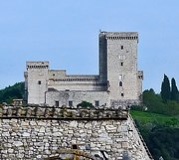
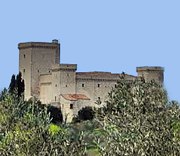
The Rocca di Narni occupies a strategic position overlooking Via Flaminia and the basin of Terni. The Emperor Frederick I seems to have fortified the site, presumably after the sack of Narni in 1174. At some time in the 13th century, the Monastero di Santa Maria Maddalena was established here for a community of Poor Clares. It is likely that this nunnery was destroyed at some time during the second legation of Cardinal Gil Albornoz to make way for the present fortress.
Its design is usually attributed to Matteo di Giovannello, il Gattapone, on the basis that it is a smaller version of the Rocca di Spoleto. (However, the precise role that il Gattapone played at Spoleto and elsewhere is still debated.) The initial phase of its construction is associated with Giordano del Monte degli Orsini, the Capitano del Patrimonio, and Ugolino di Montemarte, who was Lieutenant General of the Patrimony in 1365-6. (These men were also associated with the construction of the broadly contemporary fortress at Orvieto). In his “Cronistoria Narnese” (1930), Edoardo Martinori says that the papal administration began its construction in 1367.
Construction continued under Cardinal Anglic de Grimoard, the younger brother of Pope Urban V, who was the papal legate from March 1368 until July 1371, and whose arms were inserted into the fortress walls (see below). It was sufficiently advanced by 1371 for the first castellan to take up residence. In 1372, the Commune of Terni refused a papal request for men to help with its construction, pointing out that Narni was a traditional enemy and also that the available men were still at work on the new walls of Terni.
[In 1373, the Orsini took Narni.]
In 1375, Francesco di Vico seized Viterbo and demolished the papal fortress there. This provoked Ghibelline rebellions at Narni, Terni and Amelia. The rebellion ended with the defeat of Francesco di Vico in October 1377.
The work on the Rocca was completed in 1378, when the Rocca was inaugurated by Cardinal Philippe d' Alençon. [Philippe d’ Alencon was one of very few non-Italian cardinals to remain faithful to Pope Urban VI. He travelled to Rome for his elevation to the purple in September 1378, and it was presumably then that he inaugurated the Rocca. He served briefly as Governor of Spoleto in June - August 1380.]
Later History
Cardinal Tommaso Orsini, the legate appointed by Urban VI, orchestrated the murder of Francesco di Vico in 1387, occupied Narni, Terni, Amelia and Viterbo. He reached an accord with the Ghibellines of Terni that left their ascendency over the political affairs of the city in tact.
Cardinal Orsini was incarcerated for a brief time in December 1387 [in the fortress of Amelia/ Perugia ?] for having spoken in Viterbo against Archbishop Giacomo III Fieschi of Genoa, the legate that had succeeded him. His brother, Ugolino Orsini laid siege to the Rocca of Narni and only abandoned the siege when Urban VI freed the cardinal.
Cardinal Orsini participated in the conclave of 1389, which elected Pope Boniface IX, and he crowned the new pope on November 9, 1389. He died in Rome in 1390.
Pope Boniface IX stayed at the Rocca in 1392. He appointed his [nephew] Giannetto Tomacelli as castellan in 1393-4.
When the Guelfs of Narni sided with the antipope Clement VII in 1394, Boniface IX gave the Rocca to the Ghibellines. They arranged its fall to Malatesta di Pandolfo da Rimini in 1395, although it soon returned to papal control.
Another papal relative, Andrea Tomacelli, who was the captain of the papal army, bought the it in 1396. He gifted it to Ludovico Migliorati in 1406. Braccio Fortebraccio took the Rocca in 1417. It was here that he executed the young son of Biordo Michelotti.
In 1424, Pope Martin V installed his Colonna relatives as castellans. Following his death in 1431, riots broke out in Narni between the followers of the new Pope Eugene IV and the Colonna, following which the Colonna were expelled from the city. As noted below, the frescoes in the so-called Cappella del Cardinale were executed at about this time.
[Emperor Sigismund stayed here en route for his coronation in Rome in 1433.]
In 1449, Pope Nicholas V came here to escape the plague, and commissioned Bernardo Rossellino to restore and strengthen the walls. Giorgio Vasari was perhaps exaggerating when he said that Rossellino "rebuilt the fortress, enlarging it with good and beautiful walls".
The Rocca housed two important relics during their transportation to Rome in the 15th century:
-
✴the skull of Saint Andrew the Apostle, which Cardinals Bessarion, Alessandro Oliva and Enea Silvio Piccolomini (later Pope Pius II) escorted in 1462; and
-
✴the relic of the Holy Lance, a gift from Sultan Bayazid II, which Cardinal Jorge Costa and Cardinal Giuliano della Rovere (later Pope Julius II) escorted in 1492.
Pope Sixtus IV stayed here for a short period during an outbreak of plague in Rome in in 1476. He commissioned further fortifications in 1484, and this work was completed under his successor, Pope Innocent VIII. It involved a second fortification in Borgo delle Arevolte (near the hospital) that was linked to the Rocca by a subterranean passage. Sixtus IV also commissioned Porta Ternana (see Walk I), which was presumably part of the same project.
-
✴The Rocca, the Porta Ternana and the wall between them can be seen in this plan (1704) of Narni by Pierre Mortier.
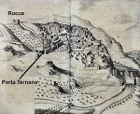
-
✴A round tower still visible above Porta Ternana originally belonged to these new fortifications.

The Spanish Pope Alexander VI appointed his compatriot Pietro Perez as castellan in 1493.
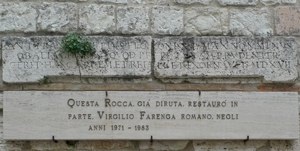
An inscription in the inner courtyard (above a modern one) records the restoration of the fortress in 1517 by the Florentine Anton Francesco Albizzi, who had been appointed by the Medici Pope Leo X as Governor of Narni in 1513.
Imperial troops sacked Narni in 1527 as they marched on Rome. The citizens of Terni took the opportunity for further attack. The Rocca seems to have been badly damaged during this period and its restoration extended until 1555.
[Even after serious attacks during the Sack of Rome in 1551 ad 1556 the fortress remained standing.]
Pope Urban VIII ordered the modernisation of the Rocca during his war against Odoardo Farnese, Duke of Parma in 1641. This work was completed by Pope Innocent X in 1649.
When Narni fell to the French in 1798, all the arms that were stored in the Rocca were taken to Perugia. These included the canon known as la Scarmigliata, which was subsequently melted down.
The Rocca served as a prison in the period 1834-1906.
In 1860, papal forces took refuge here, but volunteers from Terni led by Luigi Masi laid siege to them on behalf of the new Kingdom of Italy and they soon surrendered.
The Russian Sergej Meščerskij bought the Rocca in 1906. It remained in his family in 1972, when it was bought by a Roman family. The Commune acquired it in 1984, and it recently reopened after an extensive restoration.
Exterior
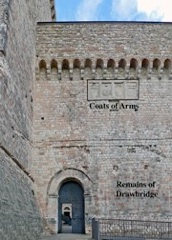
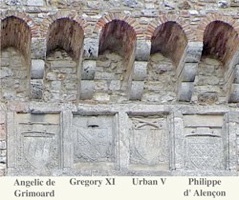
The Rocca is on a rectangular plan around a central courtyard, with a tower at each corner, the tallest tower of which (see below) is at the northwest corner, facing the city. The entrance to the courtyard, which is to the right of it, was originally protected by a drawbridge parallel to the curtain wall, the remains of which are still visible. The arms above belonged to:
-
✴Pope Urban V and Cardinal Angelic de Grimoard, who were responsible for the first phase of the construction, in 1368-71; and
-
✴Pope Gregory XI and Cardinal Philippe d' Alençon, the second of whom inaugurated the Rocca in 1378.
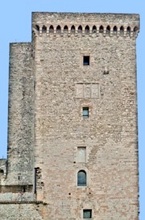
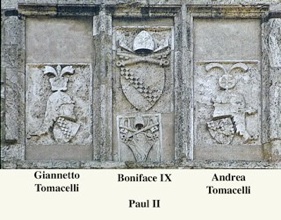
The tallest tower mentioned above is known as il mastio. The arms above the second window from the top belonged to:
-
✴Pope Boniface IX (1389-1405), who stayed at the Rocca in 1392, and two of his relations:
-
•Giannetto Tomacelli, who was castellan in 1393-5; and
-
•Andrea Tomacelli, who bought the Rocca in 1396; and
-
✴Pope Paul II (1464-71).
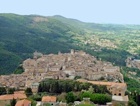
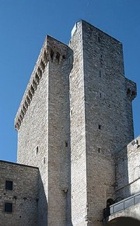
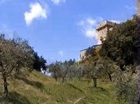
Interior
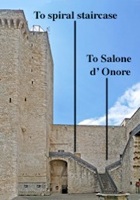
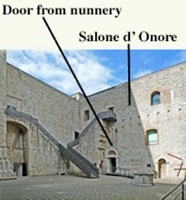
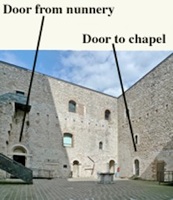
The entrance to the right of the tallest tower leads to the inner courtyard:
-
✴the double staircase on the left leads to:
-
•the Cappella del Cardinale (see below) and the spiral staircase in la femmina, to the left; and
-
•the Salone d' Onore (see below), to the right;
-
✴the entrance in front of you (see below) probably survives from the original nunnery on the site; and
-
✴the entrance to the left of the wall to your right leads to the 19th century chapel (see below).
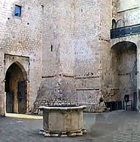
Door from Nunnery (13th century?)
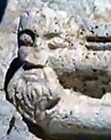
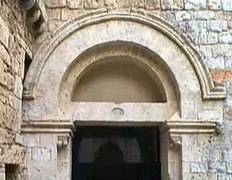

The entrance in front of you as you enter the courtyard, which (as noted above) probably survives from the original nunnery on the site, has busts of a pope and an emperor at the ends of its lintel.
Salone d' Onore
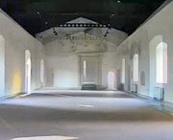
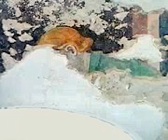

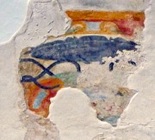
The Salone d' Onore, which was the main reception room of the fortress, was decorated with courtly scenes (15th century), of which only fragments remain. Its ceiling, which was destroyed in the Second World War, has been replaced by the present metal structure.
Cappella del Cardinale
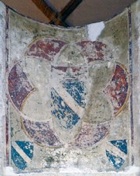
It also contains:
-
✴a fresco of the Madonna and Child enthroned with a donor and the arms of Eugene IV, which is attributed to the Maestro di Narni del 1409; and
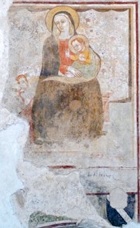
-
✴a fresco of an image of the Virgin placed on a throne.
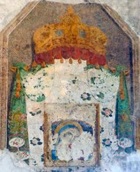
Chapel (1840)
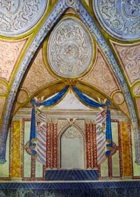
For opening hours, see the website of the Provincia di Terni.
Return to Monuments of Narni.
Return to Walk II.

